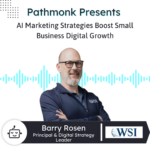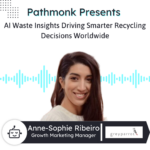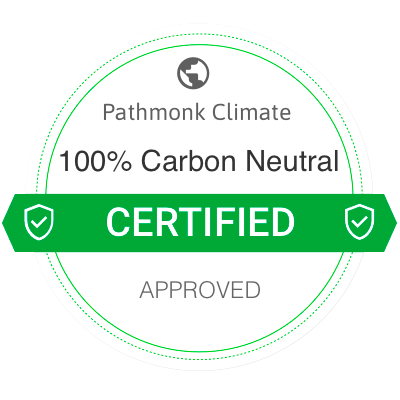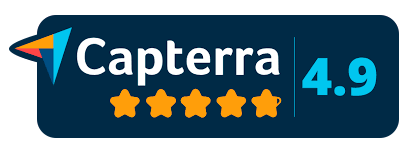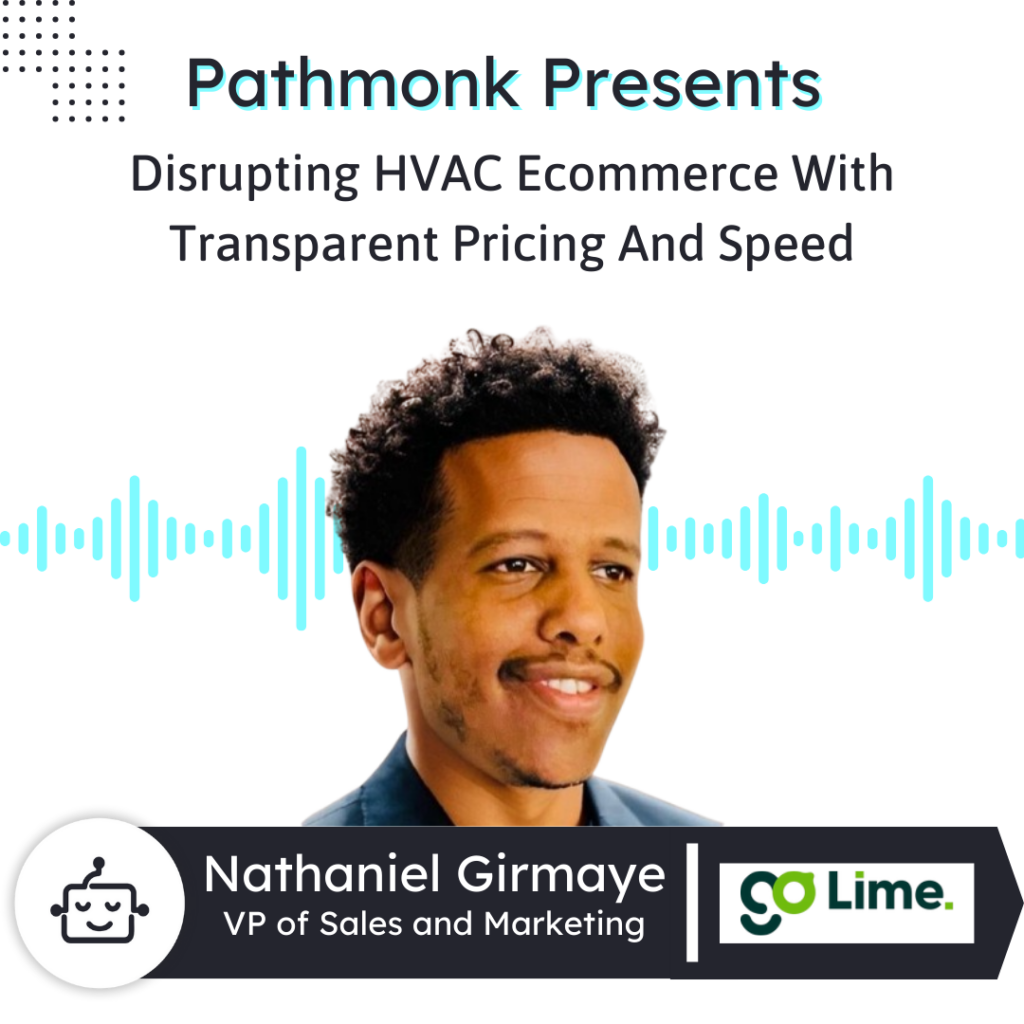
Introduction
Meet Nathaniel Girmaye, VP of Sales and Marketing at Go Lime, the Canadian startup turning HVAC upside down with a direct-to-consumer model, transparent pricing, and 24-hour installs.
Nathaniel shares how Go Lime targets Ontario homeowners, halves legacy rental costs by cutting middlemen, and uses an action-first website flow instead of classic AIDA to capture high-intent buyers.
He breaks down a tech-driven stack, relentless A/B testing, and the “sifter” mindset to match content and CTAs to buyer readiness. Expect practical insights on channel mix (Meta for awareness, Google for capture), building trust through reviews and Reddit buzz, team efficiency, and why mastering human behavior outlasts algorithm shifts.
Increase +180%
leads
demos
sales
bookings
from your website with AI
Get more conversions from your existing website traffic delivering personalized experiences.

Rick: Pathmonk is the AI for website convergence. With increasing online competition, over 98% of website visitors don’t convert. The ability to successfully show your value proposition and support visitors in your buying journey separates you from the competition online. Pathmonk qualifies and converts leads on your website by figuring out where they are in the buying journey and influencing them in key decision moments with relevant micro experiences like case studies and videos, and much more. Stay relevant to your visitors and increase conversions by 50% by adding Pathmonk to your website in seconds, letting the AI do all the work and increase conversions while you keep doing marketing as usual. Check us out on Pathmonk.com.
Hey everybody. Welcome back to today’s episode of Pathmonk Presents. Today we are joined by Nathaniel Girmaye, the VP of Sales and Marketing of Go Lime. Nathaniel, welcome to the show.
Nathaniel Girmaye: Thank you. Thank you for having me.
Rick: Of course. Excited to dive in. Nathaniel, I just want to talk about the basics. So if we were to touch on the big idea behind Go Lime and, let’s say you were explaining it to someone, to a friend over coffee… how do you describe what you guys do and what you do at the company?
Nathaniel Girmaye: Perfect. Go Lime is pretty much a basic Canadian-operated company. So what we did is we tried to flip the traditional HVAC industry over its head. We pretty much have an industry built on long sales cycles, pushy salespeople, a lot of process — from your water heater breaking to someone coming and installing it — it’s a very long process. So what we try to do is we try to decouple that and see how we can actually make it faster, better, more convenient for homeowners. And at the same time in the process, how do we save them money, right? Especially in this time. People want to save money with inflation and all that.
So that’s pretty much what we did. What we did is: the first thing is we are the first e-commerce platform, DTC platform in North America for HVAC. So we actually did that. We revamped the system at the backend, so we try to keep everything with technology as much as possible. And then if your water heater breaks, your AC breaks, your furnace breaks — you go online, with two clicks you buy it, you have all the information there, we time-install it, and within 24 hours you go ahead and start using your equipment. That’s pretty much what we did.
And for me, I run both the sales and marketing side at Go Lime, mainly focused on the marketing now, because when you go into this e-commerce platform mainly the marketing is where most is involved. That being said, because we do have a high-ticket item, there will be a position where people just don’t buy — they want to talk to an expert. So we do have an expert that actually calls homeowners, and we answer all the questions for them. That’s pretty much what we do.
Rick: Okay. You make it sound so easy, right? It’s just “Oh, this is what we do,” but that’s a lot of work that goes behind that, and I appreciate you explaining it so easily and so concisely for us.
But let’s say that I’m someone interested and I go on your website. I want to buy a product right now. Who am I? And I guess the question behind it is: what’s your ICP, your ideal customer profile? Who are they and how do they discover you even?
Nathaniel Girmaye: Definitely. We serve homeowners — any homeowners in Ontario. As of now we didn’t expand to Canada yet, but that being said, we do have a plan to go to Canada and North America. Right now we’re only focused in Ontario. So any homeowner in Ontario that has a problem with water heater, furnace, ACs… just to give you a stat, we started mainly with the water heater even though we have experience in the HVAC industry for over 10, 15 years now.
So we started just on the water heater. The reason is there are 3 million people in Ontario that are paying anywhere from $35 to $45 a month for 15 to 25 years for their water heater. So what we pretty much did is we cut that in half. We save them 50% of their payment — that is putting minimum $7,000 to $15,000 in every single pocket. We’re talking billions of dollars that we’re actually saving to Ontario residents.
So that’s the first thing that we do. And these people usually found us on Facebook and Google, which is Meta. Those are our two biggest targets. We do all our marketing there. Meta is good in creating awareness of course, and Google is very good at trapping those people. So we do them very well. We’ve been doing them for a very long time.
But for us, we also believe in — I think — word of mouth. It’s very good. So when these convert to word of mouth and start bringing more acquisition channels and more people to come to your page, that’s where it gets even more interesting. We are very happy because we see a lot of Reddit threads start about our page and what we’re doing and the change, the revolution that we’re doing in Ontario. We see a lot of people commenting or posting about us on RedFlagDeals, just saying, “Is this even true? How can they do it? Other companies are doing it at $40 and they’re doing it at $20.” But the answer is very simple: cut the middleman. There’s no commission in sales. We cut everything straight to the point. All our pricing is transparent. People can go see our pricing. So it also creates trust.
And that’s pretty much what we do. So any homeowner between the age of 35 to 65 is usually where we have homeowners in Ontario. They are our ideal customers and we’re more than happy to help them switch as fast as possible.
Rick: I think you’re doing well when you have an honest business that’s making people go, “What’s the catch?” You know what I mean? People try to understand: okay, how do you guys do it? Why is it so different? And you’re still able to pull in new business from that. That’s amazing.
Now you mentioned Meta, you mentioned Google, and that word of mouth is a big one. That’s never going to change, I’m sure. I’m curious: how much of a role does your website play when it comes to pulling in new customers? And is there anything about it that you have your eye on improving — and also of course, what’s working really well that you might be able to share with us?
Nathaniel Girmaye: Oh, yeah, definitely. So one thing that we do on the website is we don’t use the AIDA principle. I think it’s a very common principle in marketing. The reason for us is we believe that we start with action — we reverse everything. So our website is structured in a way that when people come, if they want to buy that specific product, let them buy. We don’t have to hold them by giving them more information.
I think — what is it — from back home, I’m originally not born in Canada, and I see especially when you go outside the cities, there’s women that use sifters to sift grain. And I pretty much see it that way for us at least. If people coming in — the grains that are just flowing through — they’re your buyers. Let them buy, let them go. Don’t bother them.
The people that want a little bit and are hesitant but at the same time they need more of a push — we show them the good stuff. “This is our reviews. This is what Redditors say about us. This is what our customers say about us.” We have 5,000+ 4.7–4.8 star reviews. So we show them those. We show them, “Hey, this is how we actually can give you cheaper price compared to other people. It’s not like we’re cutting the quality — we actually found a way to use technology to cut all the costs that other people have.”
And we’re willing to win so that we can get it from word of mouth, a lot of people. So those are what we show them. And then of course, there are the ones that won’t buy regardless. Now of course, if you have LTV, we track them in the future, but for those we don’t spend our time — we put them and try to give them educational information. And that’s pretty much how we put our website.
For us, simplicity wins a thousand percent. Clarity is much better than clever. We focus on — I think there’s a fine line in e-commerce platforms where you don’t want to have a lot of information and now the conversion is a problem, and you don’t want to have too little information where people don’t have enough to buy — especially for high-ticket items. Because ours is usually, on average, AOV is I’ll say $2,500 to $3,000. So it’s a high-ticket item.
So what we found is — yes, the basic CRO answer would be “Hey, why don’t you divide them and have a landing page that’s for SEO, and then another page…” But it’s different because we want to guide people and we want to direct them there.
So I think what we’re doing is: we use a lot of testing. We use a lot of tech stack as much as possible. Everything in the website earns a spot. If it’s useful information for SEO and doesn’t need to be there to help the customer decide, we put it in an embedded file. And then of course we have our blogs to help us.
So that’s pretty much what we do on the website. Again, every single thing — every CTA, every action, every word, every copy, every image — we test it with A/B testing nonstop. We’re obsessed with performance — a thousand percent, all our team members — and we want to make sure we’re focused on that as much as possible.
Rick: Love to hear that. We share that in common as companies. Pathmonk, we also obsess over performance. And I love that analogy that you use with the sifter, right? Because people will go through. And I think I might — I’m just assuming here — there’s a culinary, food-making type of analogy there that you’re using. Someone sifting through flour or something like that to make something.
Okay, amazing. I like that. Out of interest, where were you from originally? What were you thinking about — what kind of food?
Nathaniel Girmaye: Yes. I was born in Ethiopia.
Rick: Got it.
Nathaniel Girmaye: Which is East Africa. Yeah. So now I’m here full-time, and I’ve lived in Canada for a very long time now. But interesting — I was not born here. I was born in Ethiopia and I was born in the capital city. So mainly I didn’t see that too, but when I go outside of the city, people doing that.
Rick: Is that what you use to make the — what do you call it — the injera? Is that the name?
Nathaniel Girmaye: Yes.
Rick: They do that with the injera as well, correct?
Nathaniel Girmaye: Yes.
Rick: So you’re familiar with Ethiopia? That’s cool. Oh, I love Ethiopian food, so yeah, I know something about that. Definitely.
Amazing. Now let’s switch gears for a second and let’s talk about you. What does a typical workday look like for you? Is there anything specific that you focus on day-to-day as a VP of Sales and Marketing? It covers quite a lot, right? What’s a day in the life of Nathaniel?
Nathaniel Girmaye: So two things. I try to divide my day in two, three ways as much as possible. One is the visionary side — the strategic moves that we’re going to make. How we’re going to expand, how we’re going to target certain things, what is the strategy that we’re going to use, are we going to expand in certain criteria, certain campaigns and all of that.
And the second one is: how are we doing? How are my team performing? How can I remove the bottlenecks for them? How can we move very fast? I’m very focused on efficiency and cutting repetitive things as much as possible.
So I divide it in two ways: the visionary side, the strategic side, and then also how can we cut bottlenecks, how can we make our team move faster. Because I believe if we have a system that is designed very well, your team members won’t need approval — they will start making approval themselves. And I think as an individual or as a leader, I see myself — if I have created a system for my team to work very well and also have the “why,” not just “because we need to hit this number,” but “the reason we need to hit this number is because of these reasons,” I think that’s very crucial. And I make sure they understand that.
So it’s divided into two ways. Everything that we do is 80–20%. I think everyone does that. 80% of whatever is working, 20% is the experiments. It could be a new channel or a new campaign that we’re going to start. We usually think outside the box as much as possible. So that 20% is focused on that. And then how can we do new things? And then we come together and say, “Okay, how can we make it better?” And that’s pretty much how my day is from day to day.
And of course there’s more detailed stuff around that — right? Like sometimes you can read comments, you can read what’s going on, how can we make it better. Talking to different departments is also very crucial. Talking to your experts. Talking to your different departments from installation — if we want to expand somewhere else, how can we expand, what can we do. So those are small things, but the main two are those two.
Rick: Okay. It sounds like you’re really organized in that sense, and I love that you talk about helping your team become more efficient. Not starting from “Okay, how do I remove friction and make you a really productive producer” but also: “Let’s understand the vision behind that and get your buy-in,” right?
Because you can tell people what to do and they’ll do it, but at the same time, you want people invested. You want people motivated to do it so they can see what they’re working on. It gives them a sense of accomplishment. So that’s really good leadership, I would say. That’s up to you.
Now, there’s a lot of content out there, Nathaniel, and I’m wondering: how do you stay focused? How do you keep learning in this landscape? Because obviously as a leader, you need to stay on top of things in that sense and keep learning. Is there anything that you rely on — places, routines, or anything like that? On a personal level, let’s say.
Nathaniel Girmaye: Definitely. I’m a sponge — but a selective one, I’ll say. I read a lot of books, case studies, founder stories, because to be honest, the right book can give you 10 years of someone’s experience in a weekend, if you like.
I also follow disruptive brands closely, because especially for us, we’re a disruptive brand. What I mean by disruptive brand is: a lot of the people that I told you in Ontario only get all their equipment from two main companies. It’s been traditional. It’s been going on for a very long time. So we are trying to disrupt that.
So I read case studies about — I don’t know if it’s Liquid Death — or it could be like what Bobby did, what they have gone through, how they played bigger, how they created the category. I read a lot about funnels, funnel optimization. I’m very big at that. I also read as much as possible.
I always try to stay consistent on field research: a lot of Reddit threads, niche Facebook groups, even customer shopper transcripts. The beauty is I don’t have a full transcript, I don’t have Facebook accounts for myself, Reddit for that matter — but you can find this stuff a lot. So I try to learn as much as I can.
But my biggest superpower, I’ll say, or how I keep myself updated, is I read a lot of books. I try to read at least one book every one and a half to two weeks as much as possible. And the majority of the books I read about are disruptive businesses and thinking outside the box and how can we create something different. And it could be funnels. A lot of funnels from the gurus, like Dan Kennedy — I try to read what they did and how they achieved it and what technology has changed through time. And I try to challenge them as much as possible because with the AI world right now, a lot of things are changing. So what used to work five years, 10 years before does not mean it works now. So I try to see how can we bring AI and make it even better or scale it 10x or 100x. And that’s pretty much how I’ve done myself.
Rick: Sounds like there’s a lot of info that you yourself are sifting through — just to keep that analogy going — through the books you read. Because it’s a lot of books, but obviously you have to condense it at some point to be able to make it practical and use it in your daily life. Case studies, books, things of that nature. I love it.
Let’s keep it on that note — it’s the perfect transition into our last segment of the podcast. For people who are not familiar with it, at the end of each podcast we do a rapid-fire segment. So it’s just rapid-fire questions, we’re trying to keep things light and engaging. Are you ready for that?
Nathaniel Girmaye: Yep, a hundred percent.
Rick: All right, let’s do it. Speaking of books — what is the latest book or the most impactful book you picked up recently? And were there any ideas or gems that really stuck with you?
Nathaniel Girmaye: Think Wrong. I just finished reading Think Wrong. I think it’s a very good book. I just started reading Alchemy right now — it’s very interesting. I think it’s a very good book. I still didn’t finish it, so I’m still reading it, by Rory. It’s actually a very good book.
Okay, I would suggest that anyone who is a founder who wants to — who’s trying to disrupt industries — I would suggest Blitzscaling. I think it’s written by the LinkedIn founder. I would highly suggest Decoupling the Customer Value Chain — I think it’s written by the Harvard professor, I forgot his name. Those two books are very good. Play Bigger is an amazing book. The title doesn’t explain how dense the book is. I think they should have found a better title for it. But it’s one of the best books that I like, especially if you want to create your own category. But these are the books I would suggest.
Rick: Amazing. Thanks for the reading list — I’m sure many of our listeners will eat that up.
Now, if you had a magic wand, Nathaniel, and you could fix one frustrating thing in your marketing life in tech, what would it be?
Nathaniel Girmaye: Knowing where people are stuck. If there’s no boundary — imagine: knowing where the customer is 80% sold, but one thing that’s holding them is because they didn’t like one review that they saw. And if we can address it — or it could be a customer stuck in buying some stuff, they’re 50% off, but they didn’t know there was reinstallation. I think knowing that is very good — not to, again, putting unethical marketing around it — just to address exactly that part. I think if you can read it, it’s more like mind-reading, right? If we can understand where people are stuck and we can target exactly that, I think that part of the funnel would be very good.
I know there’s technology coming in to make things much better in the AI industry — to tell you where customers are stuck, in text or whatever. But I think this is beyond that. And I think if that is possible, all our lives would be much easier, I’ll say, for marketers.
Rick: Oh yeah. I love that. And we set no boundaries, right? So why not?
Nathaniel Girmaye: But if you — I think I’ll focus on attribution. I think it’s a very big struggle. Where did the attribution come from? Does Facebook take the credit or Google or Reddit or whichever we use? I think that’s very big. There’s great platforms like Triple Whale and stuff that does it, but even that is not 100% right. So if we put boundaries, I think that would be the fastest thing I’ll say together. But with no boundaries — definitely I’ll take the first option.
Rick: Yeah, you and about a billion other marketers, I would say. That’s the common struggle for sure. Attribution is a big one. But yeah, that’s a good one too — with boundaries, more attainable probably in the short term, I’m sure.
You touched on this just a short couple minutes ago about repetitiveness, right? So what’s one repetitive task that you’d love to put on autopilot forever?
Nathaniel Girmaye: Good question. I think from — I run into — I have a lot of marketers that run into me. I think all of them have their own challenge. For example, for graphic designers — if you can have, and we also have done this: you design a picture, now with technology, AI can replicate those images, and then you can connect it with Figma, and Figma will go ahead and approve it on Slack. I think these are very repetitive things that they don’t need to do.
For your performance marketers, they might be able to see what ad is working, what ad is not working — they don’t have to go manually and do it, but if you have a system — which we do — like every Monday it sends us: “These are the top-performing ads.” These are repetitive tasks that people do, and we’re actually changing by tech stack.
I think these were very big frustrations for us back, let’s say six months ago or five months ago or so. At this point we are very good — everything is in a kind of autopilot — so I wouldn’t say exactly this, but I can definitely tell you these were major problems for us.
Rick: Yeah, it’s a bunch of things, right? So it’s not just one thing, but how the system works together and all the processes within it.
Okay, so last question. If you could go back and give your past self a quick pep talk at the beginning of your career, what kind of advice would you give yourself?
Nathaniel Girmaye: Master human behavior before you master any platform. Because a lot of tools can change, a lot of channels can change, a lot of algorithms can change — but if you master human behavior — what makes them buy, what makes them decide, what makes them trust you — I think that is something that’s very good.
I started in sales when my journey — not as a marketer — so I think it helped me a lot because I used to see a lot of people every single day. So I can understand from that — it was an easy transition, but I would have doubled down on that for sure.
Yeah. I think the second thing I would do probably is: if I could go back, I’d also start building my personal brand from day one, a thousand percent. Document what worked. Share my thinking. Let people see how I solve problems or lead teams. Because I think as a leader, your personal brand is not just for you — it’s also for your team. It attracts talent, it builds your partners’ trust. So it does all that, right?
So I think I would do that as well. But yeah, if I have to go back, I would definitely tell myself to do those two for sure.
Rick: That’s a good one. It’s an overarching, good skill to have no matter what you do. But yeah — that’s beautiful advice.
Now Nathaniel, I want to thank you for being with us on the show today, and we’ve come to the end of our time here at Pathmonk Presents. I also want to give you the last word. So if someone forgets everything about the interview today — what is the one thing that they should remember about the work you guys are doing?
Nathaniel Girmaye: You mean for Go Lime? Yeah. We’re saving a lot of money for a lot of homeowners, and we’re disrupting a very old industry into something much more fun, much better, much more cost-effective for homeowners.
Rick: It’ll be beautiful to watch it unfold. So if someone in Ontario at this point, as you say, needs your products and your services, where should they go?
Nathaniel Girmaye: They can go to GoLime.com. They have all the information there. And of course, with every CTA — Buy Now — we have “Ask an Expert.” They’re more than happy to press that and then our lovely experts can guide them with all the questions that they have.
Rick: Amazing. Nathaniel, thank you again for joining us. Hopefully we get to do this again sometime soon. But in the meantime, thanks for joining us and wish you a wonderful day.
Nathaniel Girmaye: Thanks so much, Rick.
Rick: Thanks for having me.
Nathaniel Girmaye: Take care.
Rick: All right. Bye everyone.




